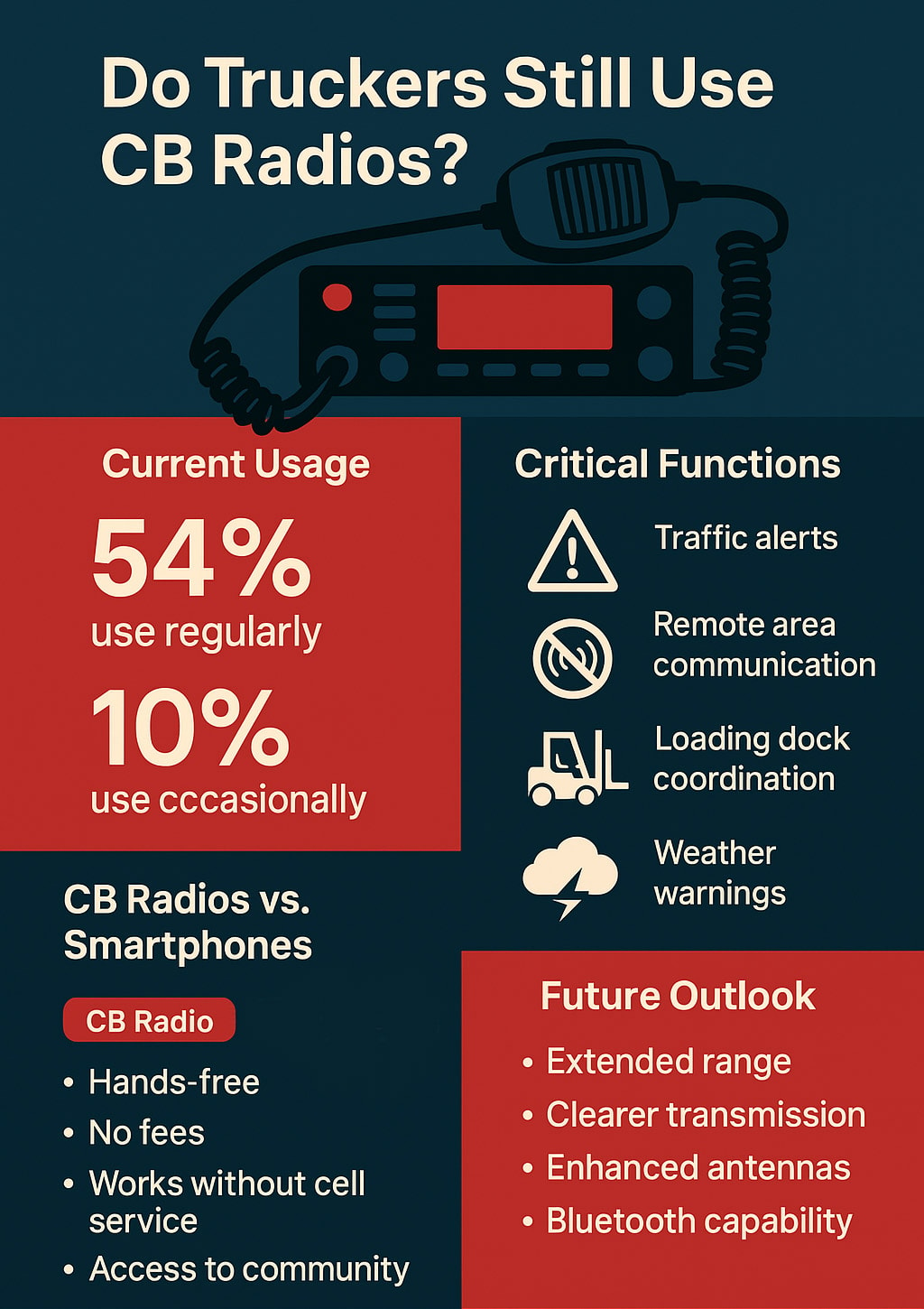CB radios remain essential equipment for 54% of truck drivers across America's highways with another 10% using them occasionally. Professional drivers rely on these devices for real-time road conditions where cell phones fail. Channel 19 provides traffic alerts and weather warnings in areas without cell service, making this decades-old technology irreplaceable for modern trucking operations.

The Evolution of CB Radios in Trucking Culture
The FCC established CB channel regulations in the 1940s, but truckers fully adopted them in the 1950s and 1960s as essential communication tools for long-haul journeys.
The 1970s marked the "Golden Age" of CBs when these devices became integral to trucker identity. During nationwide fuel shortages and speed limit implementations, drivers used CB radio to share information about:
-
Road conditions affecting route planning
-
Patrol locations to avoid speed traps
-
Fuel availability during shortages
-
Weather hazards requiring immediate attention
This era created a unique culture with distinctive terminology including "Smokey Bear" for state troopers and personalized "handles" for individual identification. Films like "Smokey and the Bandit" cemented CBs in American cultural consciousness.
Current CB Radio Usage Among Truck Drivers
Recent data confirms CB radio usage maintains relevance in modern trucking:
-
54% of truckers use CB radios daily
-
10% maintain CBs for occasional use
-
Highway communications concentrate on channels 17 and 19
-
Channels 9 and 10 serve exclusively for emergency communications
Regional variations exist with some areas favoring alternative channels like channel 14. CBs serve 4 critical functions beyond basic communication:
-
Emergency coordination during roadside trouble
-
Local area route advice from experienced drivers
-
Dock assignments and arrival coordination
-
Communication between trucks and dispatch
Practical Applications of CB Radio on Modern Roads
Many drivers rely on CB radio for 5 practical applications despite smartphone technology:
-
Immediate traffic jam updates - Truckers broadcast accidents and congestion in real-time without cell phone dependency
-
Remote area communication - CBs function where cell service fails
-
Loading dock coordination - Drivers communicate with loader operators
-
Multi-user broadcasting - Simultaneous alerts reach other truckers about hazards ahead
-
Weather condition warnings - Trucks share visibility issues and dangerous conditions
CBs require no subscription fees and withstand harsh conditions that damage electronic devices. Channel 19 fosters a unique trucking community where drivers talk during long hauls across interstate highways.
CB Radios vs. Smartphones: Why Truckers Choose Both
Professional truck drivers implement a dual-technology approach, using both CBs and smartphones for their complementary strengths.
CB radio provides:
-
Instant, hands-free communication from behind the steering wheel
-
No service fees or subscription costs
-
Function without cell service in country areas
-
Community access to other truckers on dedicated channels
Cell phones offer:
-
Logistics apps for route planning
-
Global connectivity for personal communications
-
GPS navigation with traffic integration
-
Digital documentation management
When phones lose signal in remote areas, CB radios maintain communication capabilities. When privacy or advanced features become necessary, smartphones fill those requirements. This strategic dual-technology approach maximizes safety and efficiency on the road.
The Future Outlook of CB Radio Technology in Trucking Industry
CBs will evolve rather than disappear from trucking operations. Manufacturers develop hybrid models integrating traditional functionality with modern features including:
-
Extended range capabilities beyond the typical 15-mile limit
-
Clearer transmission reducing noise interference
-
Enhanced antenna technology for improved reception
-
Bluetooth connectivity with existing devices in the cab
A generational divide exists with truckers today preferring smartphones, but CB radio remains irreplaceable for:
-
Emergency situations requiring immediate assistance
-
Convoy coordination across multiple trucks
-
Areas with poor cell service throughout America and Canada
-
Real-time road conditions updates from other drivers
CB's and newer technology will maintain a complementary relationship rather than competing for dominance in carriers' vehicles.
What Is the Typical Range of a CB Radio?
A CB's range extends up to 15 miles, varying based on terrain, antenna quality, weather conditions, and time of day. Mountains, buildings, and dense forests reduce effective range while open highways maximize transmission distance.
How Much Does a Quality CB Radio System Cost?
Quality CB radio systems cost between $110-$400, depending on features and brand. Entry-level Cobra receivers start at $110, mid-range Uniden systems cost $170-$250, and premium Stryker units with advanced features reach $400.
Is Special Training Required to Operate a CB?
CB operation requires no special training or licensing in the United States. Operators must simply comply with FCC regulations regarding certified equipment, power limitations (4 watts maximum), and proper channel usage.
What CB Radio Slang Terms Remain in Use Today?
Active CB slang includes "10-4" (affirmative), "10-20" (location), "bear" (police), "chicken coop" (scale houses), "hammer down" (drive fast), and "four-wheeler" (car) during regular communications.
Can Truckers Communicate with CB Radio at Truck Stops?
Truckers communicate effectively with CB radio at truck stops with range covering the entire facility. Drivers coordinate parking, share scale house information, and alert others about available services without leaving their trucks.
For readers interested in broader trucking industry topics, explore our related articles for valuable insights. Learn how major carriers like UPS and FedEx integrate communication technologies in "Largest Trucking Companies in US (2025)", where industry leaders with combined revenues exceeding $150 billion maintain fleet-wide communication standards. International drivers utilizing CB radio should also understand licensing requirements detailed in "What is Non-Domiciled CDL?", which explains how foreign nationals can legally operate commercial vehicles while navigating communication protocols across state lines.

.thumb.jpg.79710ba0be5a9f3be83fb45bcaf36e79.jpg)